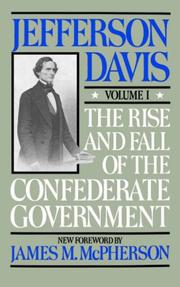Written after the close of the Civil War, and after Jefferson Davis had long been relegated to a life away from the public arena, The Rise and Fall the Confederate Government reads as a defense of the right of the southern states to secede from a country that had failed to live up to the promises of the constitution. For Davis, the crux of the issue surrounded to what extent the federal government did or did not secure and protect the rights of the various states of the union, and where the sovereignty of the people was vested.
Davis reaches back to the framers of the constitution to discuss the varying interpretations of states' rights. Not surprisingly he claims that the spirit of southern secession was more in-line with the intent of the framers when they endeavored to bring the various states together under the banner of one larger government. While history remembers the perspective of the winners, Davis counters popular retellings of the Civil War by casting northern aggression as disruptive of the desires of the south, writ large, to peacefully dissolve its part in the union. By claiming that the United States was first and foremost a compact of sovereign states, which had come together under the guise of the common welfare, Davis casts the argument as the rights of the people against a tyranny of Union (northern) powers.
Though Davis continues to belabor his central argument, the work moves along to describe secession and the opening of the Civil War. Though Davis' work sometimes gets bogged down in the internal machinations of politics and bureaucracy it is undeniably of interest to any student of American history. Where the work struggles is in Davis' defense of his own actions and too much focus on the nuts-and-bolts military details (it was known at the time that Davis would have preferred a generalship in the confederate army to the presidency). Though far from a masterpiece, Davis' work allows the reader to explore many aspects of how the confederacy thought of itself, and how it imagined the direction of the United States.
